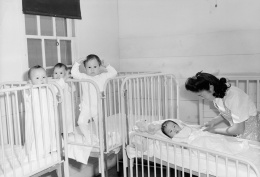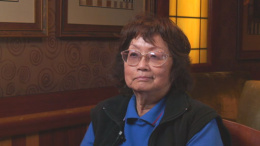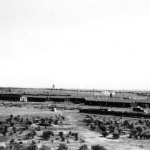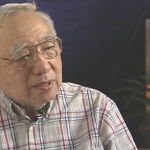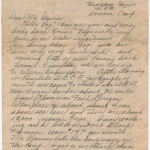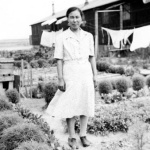Manzanar Children's Village
An orphanage located within Manzanar concentration camp. Consisting of three one-story buildings, Children's Village was established as a result of an order by the U.S. Army that orphan and foster children of Japanese ancestry were also to be incarcerated with their Japanese American caregivers. [1] Originally, sixty-one children from various orphanages and foster homes were brought by bus to Manzanar in June of 1942. [2] A total of 101 children would eventually be confined at the Children's Village until the orphanage closed in September of 1945. [3]
Before the War
Before 1942, the majority of orphan children of Japanese ancestry either lived with distant family members or foster families, or they were placed in one of three orphanages in California specifically for children of Japanese ancestry: the Salvation Army Home in San Francisco, the Maryknoll Home in Los Angeles, and the Shonien in Los Angeles. [4] Occasionally, other mainstream orphanages, hospitals, and service institutions accepted a child of Japanese ancestry. [5]
Many of the Nisei and Sansei children who were sent to Children's Village became orphans before the war as a result of family hardships, economic instability, and racial discrimination. [6] In some cases, children were placed in a home when their two working parents could not afford to raise them. Children also became temporary or half-orphans when a parent, unable to provide care, placed the child in a home. [7] Nineteen children placed at the Shonien were orphans of mixed race heritage. [8]
Wartime Incarceration
Life at children's homes for Japanese American orphans changed after the Japanese bombing of Pearl Harbor on December 7, 1941. Rokuichi "Joy" Kusumoto, the director of the Shonien Home, for example, was arrested and sent to Missoula, Montana the day after Pearl Harbor. [9] The decision over who would care for the children after Nisei staff members were removed and incarcerated was ultimately left to federal and military authorities as well as the California State Department of Social Welfare (SDSW). [10] Shonien board member Dr. T.G. Ishimaru and staff members such as Harry and Lillian Matsumoto (who would ultimately become the superintendents of Children's Village) advocated for keeping the orphans and their caregivers together during incarceration. [11]
In April of 1942, military personnel, the United States Children's Bureau, the Social Security Board, and the SDSW decided that staff from the Shonien and Salvation Army Home would relocate with the first group of orphan children. [12] On June 23, 1942, staff members and the first group of orphan children boarded military buses heading to Manzanar and the three barracks called "Children's Village." [13]
Children's Village was located in the northwest section of the camp, near the 250-bed hospital and across from barracks 28 and 29. A camp within a camp, the three barracks were planned specifically for the care of orphan children in mind. Unlike the family barracks, each barrack had running water and bathrooms. One building held the staff apartments, a recreation room, kitchen, and dining room. The second building housed three separate dormitories for infants, small children, and girls. And the third building was separated into a dormitory for small boys, another dormitory for older boys, and a storeroom. [14]
The majority of children incarcerated at Children's Village were from California orphanages and foster homes, but children from Washington, Oregon, and Alaska were also detained. [15] At the time of admission, fifty percent of the children were under seven years of age, and 29 percent were under four years of age. [16] Other children needing temporary or long-term care arrived after 1942. [17] While the majority of children were from families where both parents claimed Japanese heritage, approximately nineteen percent of the children at the Village were mixed race and had been placed in foster homes and orphanages by their families prior to World War II. [18]
Most of the children sent to Children's Village had already experienced institutional life as a result of living in an orphanage. They were used to communal life, and the staff at Children's Village maintained a daily schedule similar to the one that had been in place at the Shonien Children's Home: school followed breakfast and a Christian chapel service. [19] After school, boys and girls studied and did homework, took classes in arts and crafts, and participated in organized recreation. Dinner was served at 5:00 pm. Children and staff ate together in the Children's Village dining hall. The younger children went to bed at 7:30 pm, and the rest of Children's Village had a curfew of 9:00 pm. [20]
After the War/Current Status
For many of the orphans at Children's Village, leaving camp was the most traumatizing experience of incarceration because many of them were leaving the only family they knew. [21] Furthermore, because many of the children had been sent to Manzanar without the appointment of a guardian, many children at the end of the war had no guardians to claim or speak for them. Guardianship was even more problematic when records important for child placement had been lost during the process of removal and detention. In some cases, camp authorities had to go through the difficult process of finding the records of parents or relatives of a child to either reunite them or to determine the child's legal residence. [22] Children who had no guardians to claim them, like children who were wards of the state, had to wait until an adoptive family, foster home, wage home, or other placement was found for them. [23] Children's Village closed its door in September of 1945.
Today, the National Park Service at the Manzanar National Historic Site maintains an information slide about Children's Village at the site where the orphanage once existed. Many of the former staff and children who lived at the Children's Village were interviewed for the Children's Village Oral History Project, and these oral histories have been archived at the Center for Oral and Public History at California State University, Fullerton.
For More Information
Children's Village Oral History Project. California State University, Fullerton. Center for Oral and Public History.
Irwin, Catherine. Twice Orphaned: Voices from the Children's Village of Manzanar. Fullerton, CA: Center for Oral and Public History, 2008.
Kuramoto, Ford. A History of the Shonien, 1914-1972: An Account of a Program of Institutional Care of Japanese Children in Los Angeles . San Francisco: R and E Research Associates, 1976.
Nobe, Lisa. "The Children's Village at Manzanar: The World War II Eviction and Detention of Japanese American Orphans." Journal of the West 38.2 (April 1999): 65-71.
Spickard, Paul. "Injustice Compounded: Amerasians and Non-Japanese Americans in World War II Concentration Camps." Journal of American Ethnic History 5.2 (1986): 5-22.
Spickard, Paul. Japanese Americans: The Formation and Transformations of an Ethnic Group . New York: Twayne Publishers, 1996.
Whitney, Helen. "Care of Homeless Children of Japanese Ancestry during Evacuation." M.A. thesis, University of California, Berkeley, 1948.
Footnotes
- ↑ Ford Kuramoto, A History of the Shonien, 1914-1972: An Account of a Program of Institutional Care of Japanese Children in Los Angeles (San Francisco: R and E Research Associates, 1976), 34; Catherine Irwin, Twice Orphaned: Voices from the Children's Village of Manzanar (Fullerton, CA: Center for Oral and Public History, 2008), 7.
- ↑ Helen Whitney, "Care of Homeless Children of Japanese Ancestry during Evacuation" (M.A. thesis, University of California, Berkeley, 1948), 28.
- ↑ Whitney, "Care of Homeless Children of Japanese Ancestry during Evacuation," 29; Irwin, Twice Orphaned , 7.
- ↑ Whitney, "Care of Homeless Children of Japanese Ancestry during Evacuation," 13; Irwin, Twice Orphaned , 3.
- ↑ Whitney, "Care of Homeless Children of Japanese Ancestry during Evacuation," 13.
- ↑ Kuramoto, A History of the Shonien, 1914-1972, 11-12; Paul Spickard, Japanese Americans: The Formation and Transformations of an Ethnic Group (New York: Twayne Publishers, 1996),37-46, 70; Irwin, Twice Orphaned , 3.
- ↑ Kuramoto, A History of the Shonien, 1914-1972 , 14-16. See also Whitney, "Care of Homeless Children of Japanese Ancestry during Evacuation," 15, 28. According to Kuramoto and Whitney, in some cases, a parent or guardian temporarily placed a child in an orphanage for a few days or even months while a parent or both parents recovered from illness, divorce or economic hardship. Half-orphans refer to children with one living parent who, due to lack of child-care options, placed his or her child in a home. In many cases, temporary and half-orphans were reunited with their parent(s) during the process of removal and detention.
- ↑ Paul Spickard, "Injustice Compounded: Amerasians and Non-Japanese Americans in World War II Concentration Camps," Journal of American Ethnic History 5.2 (1986): 14.
- ↑ Kuramoto, A History of the Shonien, 1914-1972 , 42.
- ↑ Kuramoto, A History of the Shonien, 1914-1972 , 34; Irwin, Twice Orphaned , 6.
- ↑ Kuramoto, A History of the Shonien, 1914-1972 , 32-34; Irwin, Twice Orphaned , 6.
- ↑ Whitney, "Care of Homeless Children of Japanese Ancestry during Evacuation," 14-16; Kuramoto, A History of the Shonien, 1914-1972 , 34; Irwin, Twice Orphaned , 7.
- ↑ Whitney, "Care of the Homeless Children of Japanese Ancestry during Evacuation," 18, 28; Irwin, Twice Orphaned , 1.
- ↑ Whitney, "Care of the Homeless Children of Japanese Ancestry during Evacuation," 18; Irwin, Twice Orphaned , 1.
- ↑ Whitney, "Care of the Homeless Children of Japanese Ancestry during Evacuation," 62.
- ↑ Whitney, "Care of the Homeless Children of Japanese Ancestry during Evacuation," 29-30; Irwin, Twice Orphaned, 8.
- ↑ Whitney, "Care of the Homeless Children of Japanese Ancestry during Evacuation," 28-29.
- ↑ Whitney, "Care of the Homeless Children of Japanese Ancestry during Evacuation," 32-33; Irwin, Twice Orphaned , 9.
- ↑ Whitney, "Care of the Homeless Children of Japanese Ancestry during Evacuation," 39; Lisa Nobe, "The Children's Village at Manzanar: The World War II Eviction and Detention of Japanese American Orphans" Journal of the West 38.2 (April 1999): 68. According to Whitney, "Apparently, all the children [at Children's Village] were either Catholic or Protestant"(39). At the same time, Whitney writes that the children were encouraged to attend on their own "some Sunday religious services, either Catholic, Protestant, or Buddhist, for all three faiths were represented at the [Manzanar Relocation] center"(39).
- ↑ Kuramoto, A History of the Shonien, 1914-1972 , 45; Nobe, "The Children's Village at Manzanar, 68; Irwin, Twice Orphaned , 9-13.
- ↑ See oral history interview with Celeste Teodor, interviewed by Cathy Irwin, 9 Aug 2007, CSUF-Center for Oral and Public History; Nobe, "The Children's Village at Manzanar, 71; Irwin, Twice Orphaned , 231-243.
- ↑ Whitney, "Care of the Homeless Children of Japanese Ancestry during Evacuation," 41-42; Irwin, Twice Orphaned , 14.
- ↑ Whitney, "Care of the Homeless Children of Japanese Ancestry during Evacuation," 53; Nobe, "The Children's Village at Manzanar," 70.
Last updated July 14, 2020, 7:55 p.m..

 Media
Media
